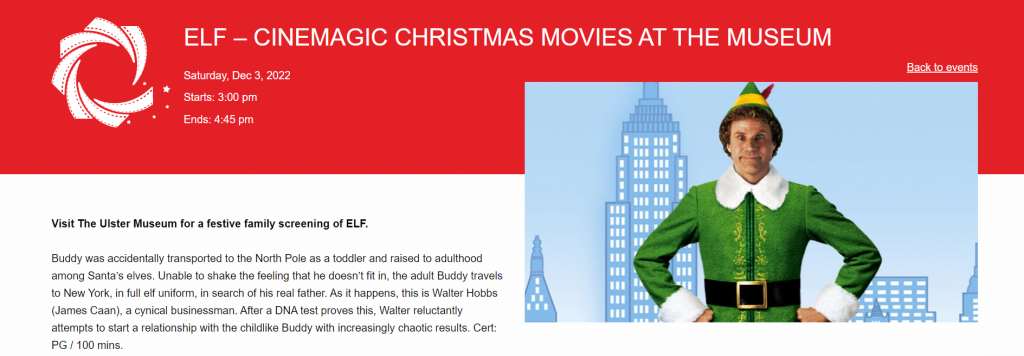The ‘Public’
There is a word that, when uttered, everyone who has had the chance to work with them will understand. It is a universal experience, whether it be in retail, customer service or even festivals.
The Public.
Majority of them are forgettable, regrettable to say but it is true – and that’s a good thing. A clear understanding of one another, a quick question, a thanks and a farewell. That’s how the general interaction with the public goes. That’s how the dream interaction goes.
Sometimes, one will encounter the person who makes the public turn into The Public. They have a problem and they will make it known that it’s not their fault, but rather yours so you have to fix it because it is their right.
Using Boud’s model, I will examine the experience, understand what happened and what I have learnt from it.

Proud to Present
It’s early-December, a Saturday afternoon and we at Cinemagic are proud to be hosting a screening of the much beloved Christmas classic Elf. The line for the screening stretches long past the gift shop and clean-up inside the hall is almost complete. To make things to faster, I pick up the clipboard and pen and begin to walk down the line, ticking names off the sheet, wishing families a fun time and carrying on.

When doors open at 3pm, the crowd bubbles and excitement grows. Children clutch their parents’ hands and tug them to get in as soon as possible. When the numbers in the queue dwindle, I take a seat and carry on with the late runners. My teammate is an experienced festival worker, she has seen the numbers Elf pulls but this? This is unprecedented.
Seats fill and the halls is loud with noise. She takes the clipboard, says she can deal with the rest of the names and asks me to enter the hall and ask everyone to pack in tight to make room for more families.
I enter and sure enough, there’s groups of families who have left two awkward seats between themselves, eating up the number of precious chairs. I ask them to move up and they do, understanding why after a brief explanation. On a roll, I approach a woman and child and ask if they could move up to make room.
She glares at me, “we were about to leave anyways.” She, along with the boy, stand and begin to pack their belongings. This was the first time I had ever encountered something like this. Panicked, I explain to her the reasoning but she does not care. I exit the hall and tell my colleague.
“Strange,” she says, “but you get that a lot.”
Farewell, Chair
I enter the hall again, checking up on the audience and notice that we were running out of seats fast. At the back of the room there is a wooden structure which children were beginning to climb up on because of the lack of space. I put out the loose chairs and lead some people to sit but it’s still not enough. I quickly tell our colleague that we’re running low and she manages to get museum staff to help deliver more chairs.
An Audience to Argue
As expected with a overbooked screening full of film fanatics and families, there is a quiet murmur among the crowd for the duration of the screening. There’s laughter, there’s gasps, and most common is the children. A child starts to cry and the parent quickly moves to calm them down out in the corridor. I’ve seen it happen at every screening. Yet, up front, a child screams and cries. Sitting at the back of the room, I cannot see what has set the child off, nor what the parent does to help them. About five minutes later, I see someone rise from the crowd and head out into the hallway. He comes back with my colleague and I see them approach the disturbance. Minutes pass, then my colleague heads back out into the hallway. Later, when the film ends, I get the doors and ask if everything was okay. She explains a man came out to tell her that the child crying was disrupting everyone and it wasn’t fair. Then, as I stand by the door and help people leave, a man says to me, “the lady [parent] did nothing wrong. Children cry so it should be expected.”
Before I can answer, another film goer comes to defend my colleagues actions. They discuss it amongst themselves before they head out and I turn to my colleague to ask her how she felt. She was anxious that she did something wrong, but people were coming out to complain about the noise. She did what she thought was right and did not expect backlash and an argument to ensue from the parent and other man. I listen to her speak and then answer her. ‘The determination of what is ‘right’ involves values; but whose values?’[1], Sekerka et al, write that honesty, fairness, respect, responsibility and compassion has a universal appeal. I believe what she did was right because the parent was disturbing the rest of the film and, yes, even though children are hard to control, she could have tried to calm her child down and my colleague handled it with care and respectfully. When we met again the next week, she told me she had explained the event to her peers and they all agreed she did nothing wrong and the parent should not have blown up at her.
What I learnt that day was that no matter how long you have worked in a job, things can still disrupt you and give you setbacks. I thought because I was still learning how to handle a large crowd, I messed up but seeing my colleague experience the same, things still go wrong. How to handle a crowd better would be to have more confidence in myself and treat them with politeness as I am a representation of the company. As long as I believe I am doing the right thing, then it is up to the public to uphold their end of the interaction. As well as this, I could have stepped in sooner and given my colleague back up to try and alleviate some of the pressure in dealing with the family.
https://www.open.edu/openlearn/mod/oucontent/view.php?id=51386§ion=4
[1] Sekerka, L.E., Bagozzi, R.P. and Charnigo, R., 2009. Facing ethical challenges in the workplace: Conceptualizing and measuring professional moral courage. Journal of Business Ethics, 89, pp.565-579.
Overcoming Obstacles
Dazed and Confused
You May Also Like

The Best Laid Plans of Mice and Men…
14 April 2023
I Was Just… A Voice.
7 April 2023
